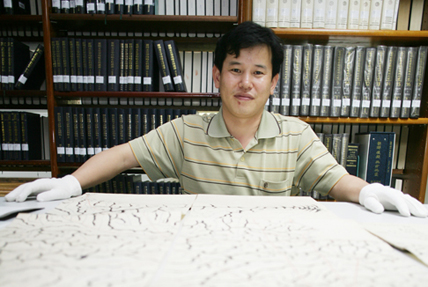
A royal library was first established as early as the mid-fifteenth century, but the 25-year-old King Jeongjo would radically transform the quiet archives in 1776 at the start of his reign. What had been just a convenient compendia of Joseon Dynasty monarchs became an powerhouse institution of"cultural governance" to foster scholarship for the ages, and a priceless resource. Literally"the building of the kings? writings," the Kyujanggak is now housed in a traditional tile-roofed structure on the SNU campus, holding within its walls a far-ranging and unparalleled collection of Korean and East Asian history and literature.
Preserving Korean Heritage in the 21st century
The Kyujanggak Institute for Korean Studies has continued to evolve from its beginnings as the royal library, while maintaining the ambitious spirit of its eighteenth century founder. This spring, the Kyujanggak hosted a week-long international symposium that underscored its role within Korean studies and Asian studiesas a whole. In the past it played a key role in the development of Korean identity and culture, and the Institute continues to function as a center with a wide range of activities including preservation, exhibition, and publication. Publications of the Kyujanggak?s holdings and its highly regarded academic journal have been major contributions to the field of Korean Studies.
But what once was the preserve of only the royal scholars, the Kyujanggak has now thrown open its doors. In any given day, the Institute receives a few dozen visitors, varying from the general public who might wander through the extensive exhibition halls to scholars who request access to the archives.
?
The Daedong yeojido Fan Club
Though scholars may make the pilgrimage to sit with brittle manuscripts, the superstar of the Kyujanggak is the Daedong yeojido. Drawn by pioneering cartographer Kim Jeong-ho in 1861, the Daedong yeojido, or the Grand Map of Korea, is renowned today for its accuracy, immense size, and for its unique material.
The map consists of 22 sets of engraved wood blocks, which when placed together form a two-meter-long picturesque version of the Korean peninsula. The Daedong yeojido features more than 18,000 place names and geographical features, an astounding increase from previous maps, and is considered to be as accurate as maps created employing modern surveying techniques. Contemporary scholars not only praise the geographer for his surprising accuracy, but for his foresight in choosing to carve the map as wood blocks. Instead of the laborious hours required to copy a drawn map, the map?s reproduction took mere moments instead.
Since its inception, the Kyujanggak has published and distributed key documents, and as a continuation of this, recently made the Daedong yeojido available not only on paper but in a digital verseion as well on the"e-kyujanggak" website. For over 230 years, the Kyujanggak has stayed committed to its original vision of"cultural governance and fostering talent." By providing open resources and the opportunity for a worldwide network of scholars, the Institute maintains the spirit of scholarship and inquiry embraced by a young king centuries ago.
Research Research Highlights
Research Highlights
Research Highlights
Research Highlights

